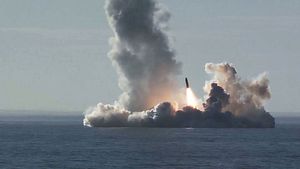The nuclear-powered ballistic missile submarine (SSBN) Knyaz Vladimir (Prince Vladimir), the Russian Navy’s first upgraded Project 955A Borei II-class (“North Wind”) or Dolgorukiy-class boomer, has for the first time fired a RSM-56 Bulava (NATO reporting name: SS-N-32) submarine-launched ballistic missile (SLBM) as part of its final certification tests, the Russian Ministry of Defense (MoD) said in an October 30 statement.
The Knyaz Vladimir launched the Bulava SLBM from a submerged position in the White Sea, an inlet of the Barents Sea, off the northwest coast of Russia. The missile hits its designated target on the Kura missile test range on the Kamchatka peninsula in Russia’s Far East, according to the MoD.
The Bulava SLBM–a sea-launched variant of the Topol-M—can reportedly be fitted with six to 10 nuclear multiple independently targetable reentry vehicle (MIRV) warheads yielding 100 to 150 kilotons apiece, as well as 10 to 40 decoys. The three-stage solid propellant (with a liquid head stage) Bulava has an estimated range of over 8,300 kilometers (5,157 miles). The SSBN Yuri Dolgoruky, an original Project 955 Borei-class boomer, last test fired a RSM-56 Bulava in August 2019.
The SLBM constitutes the new backbone of the sea-based component of Russia’s nuclear triad.
The recent missile launch is part of the final validation trials of the first-of-class Knyaz Vladimir. The Borei-(A)-II-class sub has been undergoing sea trials and other tests since November 2018. The first round of sea trials of the boomer reportedly took place in late November/early December 2018 and finished in January 2019. The second round kicked off in early July.
Borei-(A)-II-class SSBNs feature improved stealth capabilities, better maneuverability, and an increased SLBM payload, as I wrote previously:
In comparison to the Borei-class, Borei II[A]-class submarines are fitted with four additional missile tubes, boast smaller hulls and cons, and feature improved acoustics and lower sound levels, next to a number of other technical improvements.
(…) The Borei-class[is] capable of carrying up to 16 Bulava [SLBMs], whereas the improved Borei II-(A)-class can carry up to 20 ballistic missiles.
Similar to other Russian boomers, the Borei-II-(A)-class SSBN also retains a double-hull construction.
The Knyaz Vladimir is the first of a planned fleet of five Borei II-(A)-class SSBNs. In addition to the Knyaz Vladimir in 2012, two other improved Borei-A)-class subs were laid down in 2014. Furthermore, the Russian government’s 2018-2027 state armament program foresees the delivery of two yet to be named Borei II-class SSBNs, laid down in December 2015 and 2016, to the Russian Navy in 2026 and 2027.
The Knyaz Vladimir was laid down in 2012 and floated out in 2017, two years later than originally planned due to contract disputes between the Russian MoD and the Severodvinsk-based Sevmash Shipyards. The boomer is expected to be commissioned in the coming weeks.
The Russian Navy currently deploys three Borei-class SSBNs. Notably, the annual Russian nuclear forces readiness exercise, dubbed “Grom [Thunder] 2019″, which took place earlier this month, did not include the participation of any Borei-class boomers.
































